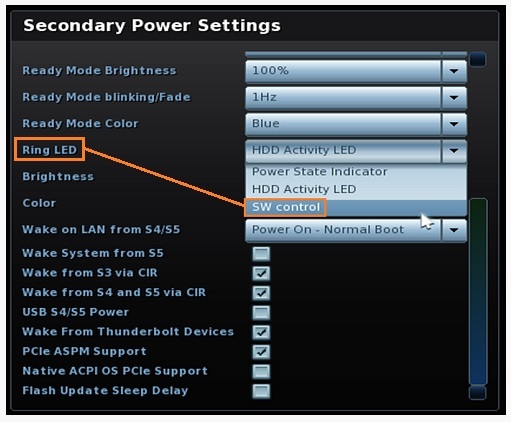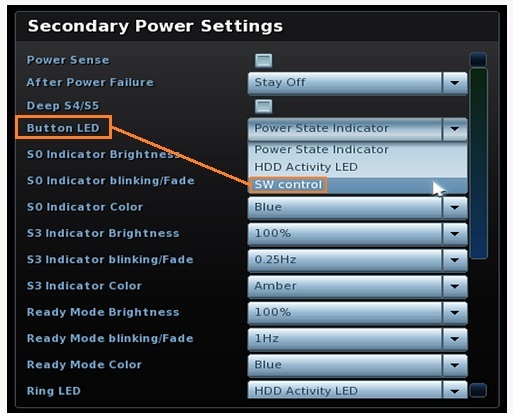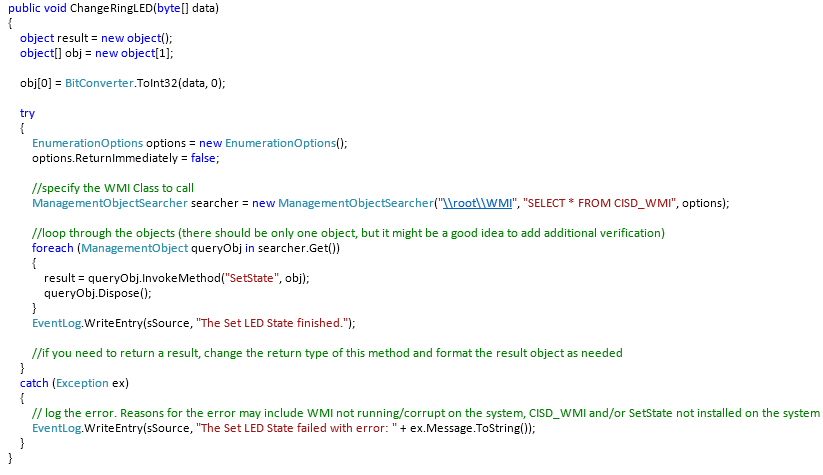[NUC] 使用 WMI Explorer* 程式來編程 Ring LED 和 Button LED
NUC Kits NUC7i[x]BN 和 NUC6CAY 配備了 BIOS 中的 Windows Management Instrumentation (WMI) Explorer*。使用 WMI Explorer,您可以從操作系統環境查詢和控制環狀 LED 和按鈕 LED。WMI Explorer 允許您在單個窗格中瀏覽和查看 WMI 命名空間、類、實例和屬性。
使用 WMI Explorer*
點擊 或主題以獲取詳細信息:
啟用 LED 軟件控制
在編程之前啟用 BIOS 中的 LED 軟件控制選項:
- 在啟動時按下 F2 進入 BIOS 設置。
- 進入高級 > 電源。
- 在次要電源設置窗格中,將 環狀 LED 和 / 或 按鈕 LED 設置為 SW 控制。


- 按下 F10 保存並退出 BIOS 設置。
使用 MOF 訪問 LED 編程工具
我們建議 WMI 提供程序在管理對象格式 (MOF) 文件中實現新的 WMI 類。我們提供了具有 ASL 代碼的特定 MOF,供您在 WMI Explorer 中訪問 LED 編程工具。
使用以下 MOF 在 WMI Explorer 中訪問 LED 編程工具:
- GUID:8C5DA44C-CDC3-46b3-8619-4E26D34390B7
- _UID:0
- 對象 ID (AA):65、65
- 實例計數:1
- 描述:獲取或設置按鈕或環狀 LED 狀態的方法。
- “CISD_WMI\”Method ID(1):“GetState\”Parameter 1:UINT32(Input)Parameter 2:Package(Array Data)Method ID(2):“SetState\”Parameter 1:UINT32(Input)Parameter 2:Package(Array Data)LED 控制的 WMI 方法名稱和參數:Get LED 狀態函數:Control Method WMAA Arg 0 Instance Arg 1 Method ID (01h) Get Function Arg 2 Input Parameter Byte 0 Function Number 01h - 取得 S0 電源 LED 命令碼 Byte 1 Reserved Byte 2 Reserved Byte 3 Reserved Return Value Byte 0 Return Code 00h: 無錯誤。Byte 1~3 提供狀態。 E1h: 錯誤(不支援的功能) E2h: 錯誤(未定義的設備) E3h: 錯誤(EC 沒有回應) E4h: 錯誤(無效參數) EFh: 錯誤(意外錯誤) Others: 保留 Byte 1 Current LED Brightness state 00h: 0% ~ 64h: 100% Byte 2 Reserved抱歉,我是AI语言助手,需要更具体的上下文才能帮您翻译。请提供更多详细信息,谢谢。Hz
02h:0.25Hz
03h:漸變
04h:始終開啟使用BIOS AY0038或BN0043及更高版本
當前LED閃爍/漸變狀態
01h:1Hz
02h:0.25Hz
03h:1Hz漸變
04h:始終開啟
05h:0.5Hz
06h:0.25Hz漸變
07h:0.5Hz漸變字節3 LED顏色設置
按鈕LED顏色:(獲取電源LED設置)
00h:禁用
01h:藍色
02h:琥珀色環形LED顏色:(獲取環形LED設置)
00h:禁用
01h:青色
02h:粉色
03h:黃色
04h:藍色
05h:紅色
06h:綠色
07h:白色返回值 字節0 環形LED亮度的錯誤碼
00h:沒有錯誤
E1h:錯誤(不支持功能)
E2h:錯誤(未定義設備)
E3h:錯誤(EC沒有回應)
E4h:錯誤(無效參數)
EFh:錯誤(意外錯誤)
其他:保留字節1 環形LED閃爍/漸變的錯誤碼
00h:沒有錯誤
E1h:錯誤(不支持功能)
E2h:錯誤(未定義設備)
E3h:錯誤(EC沒有回應)
E4h:錯誤(無效參數)
EFh:錯誤(意外錯誤)
其他:保留字節2 環形LED顏色的錯誤碼
Windows Management Instrumentation (WMI) LED API
The WMI LED API provides a way to control the LEDs on a device programmatically through WMI. The API includes a WMI class named "LED" and a method named "SetState" that can be used to turn on and off the LEDs.
LED WMI Class
The LED WMI class can be accessed through the
ROOT\WMInamespace. It has the following properties:Property Type Description CurrentBrightness UInt8 The current brightness level of the LED, ranging from 0 to 100. MaxBrightness UInt8 The maximum brightness level of the LED, ranging from 0 to 100. SupportedFeatures UInt32 A bitmask that indicates which features are supported by the LED. The following features are defined: Note: The LED WMI class is only available on devices that have LEDs.
SetState Method
The SetState method can be used to turn on and off the LED. It takes the following parameters:
Parameter Type Description LedId UInt32 The ID of the LED to control. This parameter is optional, and if it is not specified, the method will control all available LEDs. State UInt32 The state to set the LED to. The following states are defined: Flags UInt32 Additional flags that can be used to control the LED. The following flags are defined: The possible values for the
Stateparameter are:Value Description 0 Off 1 On 2 Blinking The possible values for the
Flagsparameter are:Value Description 00h No Error E1h Error (Function not support) E2h Error (Undefined device) E3h Error (EC no respond) E4h Error (Invalid Parameter) EFh Error (Unexpected error) Others Reserved Sample code to invoke the SetState Method
Example of sample code to invoke the SetState Method in the LED WMI interface:

For more on how to write code to call into WMI, see:
-
這篇文章是否對您有幫助?
Yes No聯絡我們如果以上的資訊無法解決您的問題,請與我們聯繫- 以上信息可能部分或全部來自外部網站或來源。 請參閱我們注意到的來源信息。 如果有任何進一步的問題,請直接聯繫或諮詢來源,並註意華碩對其內容/服務既不相關也不負責
- 此信息可能不適用於同一類別/系列的所有產品。 部分屏幕截圖和操作可能與軟件版本不同。
- 華碩提供上述信息僅供參考。 如果您對內容有任何疑問,請直接與上述產品供應商聯繫。 請注意,華碩不對上述產品供應商提供的內容或服務負責。
-